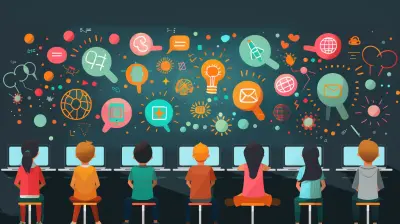How Education Policy Can Address Climate Change Education
1 September 2025
Climate change is undeniably one of the biggest challenges of our time. Rising global temperatures, extreme weather events, and environmental degradation are no longer just distant threats—they're happening right now. But how do we tackle this massive issue? One powerful way is through education.
Education shapes society’s future, influencing how people think, behave, and make decisions. If we want to create a generation that can mitigate climate change, we must integrate climate education into our school systems. That’s where education policy comes in.
But how exactly can education policy address climate change education? Let’s break it down step by step.

Why Climate Education Matters
Before we dive into policies, let’s talk about why climate education is crucial in the first place.Imagine a world where the next generation is unaware of climate change. They wouldn’t understand why their daily actions—like excessive energy consumption, wasteful habits, or unsustainable lifestyles—worsen environmental degradation. Without proper education, they wouldn't have the knowledge or skills to advocate for sustainable policies or innovate eco-friendly solutions.
Educating students about climate change:
- Builds awareness about its causes and consequences.
- Encourages sustainable behaviors and lifestyles.
- Empowers young minds to take action and push for policy changes.
- Prepares future leaders to address climate-related challenges.
In short, if we want real change, we must start in the classroom.

The Role of Education Policy in Climate Change Education
Education policy determines what students learn and how they learn it. It influences textbooks, teacher training, curriculum design, and even classroom discussions. If we want climate change education to be effective, it must be supported by strong policies.Let’s explore some specific ways education policy can promote climate education.
1. Integrating Climate Change into the Core Curriculum
Currently, many schools treat climate change as a side topic—something that’s briefly mentioned in science class and then forgotten. But climate change isn’t just a science issue; it’s a social, economic, and political issue too.What can education policy do?
- Mandate climate education across all subjects (not just science).
- Teach students about climate change in history, geography, and even economics to help them see the bigger picture.
- Include climate-related topics in standardized testing to ensure students take them seriously.
By integrating climate education into the core curriculum, we can ensure that every student learns about it, regardless of their career path.
2. Training Teachers to Teach Climate Change
Even if climate education is included in the curriculum, it won’t be effective unless teachers are equipped to teach it. Many educators lack the resources or confidence to discuss climate change in depth.How can policy help?
- Provide mandatory training programs for teachers on climate science and sustainability.
- Develop interactive teaching materials to make learning more engaging.
- Offer incentives for teachers who specialize in environmental education.
When teachers feel comfortable teaching climate-related topics, students will gain a much deeper understanding of the issue.
3. Encouraging Hands-On Learning Experiences
Let’s be honest—students learn best when they experience things firsthand. Reading about climate change is essential, but seeing its effects and working on real solutions is even better.How can policy support hands-on learning?
- Promote school projects like tree planting, recycling programs, and energy-saving initiatives.
- Partner with local environmental organizations to provide students with real-world experiences.
- Support outdoor education programs where students can explore nature and understand environmental changes up close.
By moving beyond textbooks and into real-life experiences, education policy can make climate education more engaging and impactful.
4. Promoting Critical Thinking and Problem-Solving Skills
Climate change is a complex issue that requires innovative solutions. Instead of just giving students facts, we need to teach them how to think critically and solve problems.What should education policy focus on?
- Encouraging debates on environmental policies and solutions.
- Including project-based learning to develop real-world solutions.
- Teaching students how to analyze data and make evidence-based decisions.
By fostering critical thinking, we can empower students to become problem-solvers, not just passive learners.
5. Making Climate Education Inclusive and Accessible
Climate change affects everyone, but marginalized communities often bear the heaviest burden. If education policy doesn’t address inclusivity, we risk leaving behind those who need climate education the most.How can policy ensure inclusivity?
- Provide climate education in all schools, regardless of location or funding levels.
- Offer resources in multiple languages to reach diverse communities.
- Address climate justice in the curriculum, teaching students how climate change disproportionately affects certain groups.
By making climate education accessible to all, we ensure that everyone has the knowledge and tools to take action.
6. Encouraging Government and Industry Collaboration
Schools alone can’t solve climate change—governments and industries must also play a role. Strong education policies should encourage collaboration between schools, policymakers, and businesses.What could this look like?
- Partnering with renewable energy companies to provide students with hands-on learning opportunities.
- Encouraging government grants for schools that implement sustainability programs.
- Involving students in policymaking through youth advisory councils.
When schools, governments, and industries work together, climate education becomes more powerful and effective.

Overcoming Challenges in Climate Education Policy
Of course, implementing strong climate education policies isn’t as easy as flipping a switch. There are challenges, including:- Political resistance: Some policymakers hesitate to prioritize climate education due to political controversy.
- Lack of funding: Schools may not have the resources to implement new programs effectively.
- Misinformation: Climate change denial and misinformation can make it difficult to deliver accurate education.
Despite these challenges, pushing for better climate education policies is essential. Education plays a crucial role in shaping a sustainable future, and the more we invest in it, the better our chances of addressing the climate crisis.

The Future of Climate Education Policies
So, what’s next? The good news is that more countries are beginning to recognize the importance of climate education. Some are developing new policies, while others are updating existing ones to include sustainability and environmental topics.But there’s still a long way to go. Every country needs strong, well-funded, and inclusive climate education policies. The more we push for these changes, the better prepared future generations will be to tackle climate change head-on.
Final Thoughts
Climate change isn’t just a problem for scientists or policymakers—it’s a challenge that affects all of us. And one of the best ways to fight it is through education.By shaping strong education policies that integrate climate change into the curriculum, train teachers, encourage hands-on learning, and promote critical thinking, we can empower the next generation to take action.
The future depends on how well we educate today’s students. Let’s make sure they have the tools and knowledge they need to build a sustainable world.
all images in this post were generated using AI tools
Category:
Education PolicyAuthor:

Monica O`Neal
Discussion
rate this article
1 comments
Tiffany Taylor
Essential insights! Education policy must prioritize climate change for future sustainability.
September 5, 2025 at 10:57 AM

Monica O`Neal
Thank you! Prioritizing climate change in education policy is crucial for empowering future generations to tackle this global challenge.


